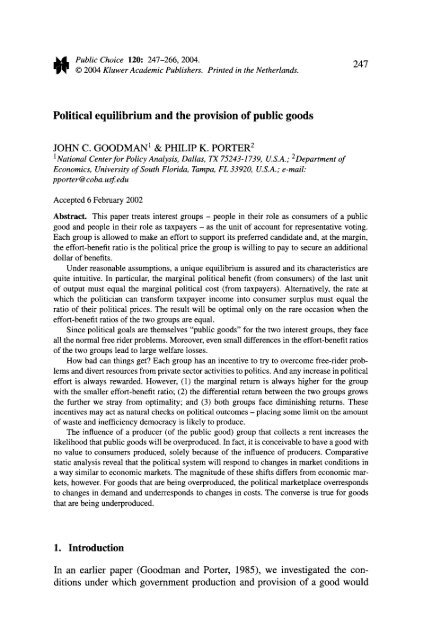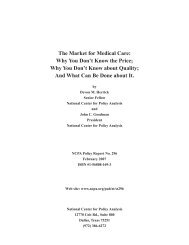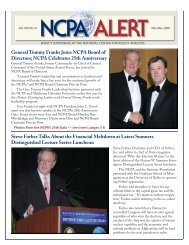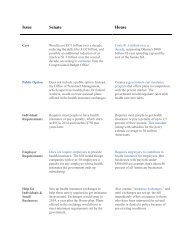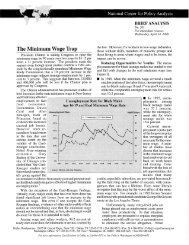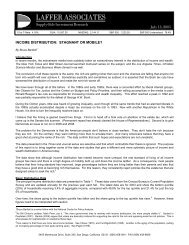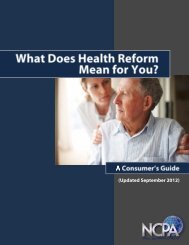Political Equilibrium and the Provision of Public Goods
Political Equilibrium and the Provision of Public Goods
Political Equilibrium and the Provision of Public Goods
You also want an ePaper? Increase the reach of your titles
YUMPU automatically turns print PDFs into web optimized ePapers that Google loves.
<strong>Public</strong> Choice 120: 247-266, 2004.<br />
© 2004 Kluwer Academic Publishers. Printed in <strong>the</strong> Ne<strong>the</strong>rl<strong>and</strong>s.<br />
247<br />
<strong>Political</strong> equilibrium <strong>and</strong> <strong>the</strong> provision <strong>of</strong> public goods<br />
JOHN C. GOODMAN' & PHILIP K. PORTER2<br />
I National Center for Policy Analysis, Dallas, TX 75243-1739, U.S.A.; 2Department <strong>of</strong><br />
Economics, University <strong>of</strong> South Florida, Tampa, FL 33920, U.S.A.; e-mail:<br />
pporter@ coba. usf edu<br />
Accepted 6 February 2002<br />
Abstract. This paper treats interest groups - people in <strong>the</strong>ir role as consumers <strong>of</strong> a public<br />
good <strong>and</strong> people in <strong>the</strong>ir role as taxpayers - as <strong>the</strong> unit <strong>of</strong> account for representative voting.<br />
Each group is allowed to make an effort to support its preferred c<strong>and</strong>idate <strong>and</strong>, at <strong>the</strong> margin,<br />
<strong>the</strong> effort-benefit ratio is <strong>the</strong> political price <strong>the</strong> group is willing to pay to secure an additional<br />
dollar <strong>of</strong> benefits.<br />
Under reasonable assumptions, a unique equilibrium is assured <strong>and</strong> its characteristics are<br />
quite intuitive. In particular, <strong>the</strong> marginal political benefit (from consumers) <strong>of</strong> <strong>the</strong> last unit<br />
<strong>of</strong> output must equal <strong>the</strong> marginal political cost (from taxpayers). Alternatively, <strong>the</strong> rate at<br />
which <strong>the</strong> politician can transform taxpayer income into consumer surplus must equal <strong>the</strong><br />
ratio <strong>of</strong> <strong>the</strong>ir political prices. The result will be optimal only on <strong>the</strong> rare occasion when <strong>the</strong><br />
effort-benefit ratios <strong>of</strong> <strong>the</strong> two groups are equal.<br />
Since political goals are <strong>the</strong>mselves "public goods" for <strong>the</strong> two interest groups, <strong>the</strong>y face<br />
all <strong>the</strong> normal free rider problems. Moreover, even small differences in <strong>the</strong> effort-benefit ratios<br />
<strong>of</strong> <strong>the</strong> two groups lead to large welfare losses.<br />
How bad can things get Each group has an incentive to try to overcome free-rider problems<br />
<strong>and</strong> divert resources from private sector activities to politics. And any increase in political<br />
effort is always rewarded. However, (1) <strong>the</strong> marginal return is always higher for <strong>the</strong> group<br />
with <strong>the</strong> smaller effort-benefit ratio; (2) <strong>the</strong> differential return between <strong>the</strong> two groups grows<br />
<strong>the</strong> fur<strong>the</strong>r we stray from optimality; <strong>and</strong> (3) both groups face diminishing returns. These<br />
incentives may act as natural checks on political outcomes - placing some limit on <strong>the</strong> amount<br />
<strong>of</strong> waste <strong>and</strong> inefficiency democracy is likely to produce.<br />
The influence <strong>of</strong> a producer (<strong>of</strong> <strong>the</strong> public good) group that collects a rent increases <strong>the</strong><br />
likelihood that public goods will be overproduced. In fact, it is conceivable to have a good with<br />
no value to consumers produced, solely because <strong>of</strong> <strong>the</strong> influence <strong>of</strong> producers. Comparative<br />
static analysis reveal that <strong>the</strong> political system will respond to changes in market conditions in<br />
a way similar to economic markets. The magnitude <strong>of</strong> <strong>the</strong>se shifts differs from economic markets,<br />
however. For goods that are being overproduced, <strong>the</strong> political marketplace overresponds<br />
to changes in dem<strong>and</strong> <strong>and</strong> underresponds to changes in costs. The converse is true for goods<br />
that are being underproduced.<br />
1. Introduction<br />
In an earlier paper (Goodman <strong>and</strong> Porter, 1985), we investigated <strong>the</strong> conditions<br />
under which government production <strong>and</strong> provision <strong>of</strong> a good would
248<br />
be Pareto optimal, given two-c<strong>and</strong>idate competition <strong>and</strong> probabilistic voting.<br />
The finding: <strong>the</strong> conditions for optimality are so extreme <strong>the</strong>y are unlikely<br />
ever to be satisfied.1<br />
In this paper we ask more basic questions. What determines whe<strong>the</strong>r <strong>the</strong><br />
good will be under-produced or over-produced How will <strong>the</strong> quantity <strong>of</strong> <strong>the</strong><br />
good respond to changes in dem<strong>and</strong> <strong>and</strong> changes in <strong>the</strong> cost <strong>of</strong> production<br />
And how are <strong>the</strong>se results affected by rent seeking on <strong>the</strong> part <strong>of</strong> <strong>the</strong> goods<br />
producers <strong>and</strong> by <strong>the</strong> charging <strong>of</strong> user fees<br />
The model used here appeared in Goodman <strong>and</strong> Porter (1988) <strong>and</strong> represents<br />
an integration <strong>of</strong> two distinct trends in <strong>the</strong> application <strong>of</strong> economics to<br />
political science. Following Stigler (1971), Posner (1974) <strong>and</strong> Becker (1983),<br />
we take <strong>the</strong> group ra<strong>the</strong>r than <strong>the</strong> individual as <strong>the</strong> unit <strong>of</strong> account. However,<br />
following Downs (1957), Buchanan <strong>and</strong> Tullock (1962) <strong>and</strong> many o<strong>the</strong>rs,<br />
we take democratic elections to be <strong>the</strong> fundamental source <strong>of</strong> political outcomes;<br />
<strong>and</strong>, hence, we model <strong>the</strong> decision-making process as a two-c<strong>and</strong>idate<br />
electoral competition.2<br />
The approach taken here also fully incorporates <strong>the</strong> principle <strong>of</strong> marginalism<br />
which states that participants in <strong>the</strong> political system can always<br />
incrementally increase or decrease <strong>the</strong> level <strong>of</strong> effort <strong>the</strong>y are willing to<br />
make to affect <strong>the</strong> political outcome; <strong>and</strong> <strong>the</strong>se incremental changes always<br />
have an impact on political equilibrium, no matter how small (Goodman,<br />
1976). This principle is notably absent in Stigler's winner-take-all model<br />
<strong>of</strong> regulatory capture, although it is central in Becker. The principle is also<br />
absent in one-person-one-vote models (e.g., <strong>the</strong> median voter model) that<br />
make voter decisions all or nothing <strong>and</strong> leave no room for <strong>the</strong> expression <strong>of</strong><br />
intensity <strong>of</strong> preference that is found in models <strong>of</strong> probabilistic voting (Hinich,<br />
Ledyard <strong>and</strong> Ordeshook, 1972). Precisely because <strong>the</strong>y violate <strong>the</strong> marginalist<br />
principle, one-person-one-vote models almost never have an equilibrium<br />
solution unless artificially constrained (Ordeshook <strong>and</strong> Shepsle, 1982; Goodman,<br />
1984). When <strong>the</strong>y do have an equilibrium solution, it is notoriously<br />
unresponsive: small changes in <strong>the</strong> preferences <strong>of</strong> voters on ei<strong>the</strong>r side <strong>of</strong> <strong>the</strong><br />
median voter have no effect on <strong>the</strong> winning platform.<br />
Moreover, if one platform can defeat all o<strong>the</strong>rs in a majority vote both<br />
c<strong>and</strong>idates in a two-c<strong>and</strong>idate contest will have an incentive to endorse <strong>the</strong><br />
winning platform <strong>and</strong> insure its electoral success. It is in this sense that <strong>the</strong><br />
characteristics <strong>and</strong> preferences <strong>of</strong> politicians "do not matter". Dye (1984)<br />
went so far as to assert that not only do politicians not matter, <strong>the</strong> institutional<br />
structure <strong>of</strong> government doesn't matter ei<strong>the</strong>r.3 However, <strong>the</strong>re have been<br />
a number <strong>of</strong> recent empirical studies showing that institutions do matter.<br />
Merrifield (2000) has a useful review <strong>of</strong> <strong>the</strong> literature on state government<br />
spending <strong>and</strong> presents his own evidence that spending to produce goods pub-
249<br />
licly is affected by such institutional variables as <strong>the</strong> number <strong>of</strong> legislators,<br />
<strong>the</strong> length <strong>of</strong> <strong>the</strong> legislative session, initiative <strong>and</strong> referendum, line item veto,<br />
etc. Persson <strong>and</strong> Tabellini (1999) produce international evidence that public<br />
spending on goods is affected by whe<strong>the</strong>r elections are majoritarian or proportional<br />
<strong>and</strong> whe<strong>the</strong>r political regimes are presidential or parliamentary. On<br />
<strong>the</strong> specific question <strong>of</strong> public production <strong>of</strong> goods, a useful summary <strong>of</strong> <strong>the</strong><br />
recent literature is in Persson <strong>and</strong> Tabellini (1999). This includes legislative<br />
bargaining models (Baron <strong>and</strong> Ferejohn 1989; Baron 1991); bargaining<br />
between a president <strong>and</strong> local representatives (Chari, et.al., 1997; <strong>and</strong> Weingast,<br />
et.al., 1981); <strong>and</strong> comparison between congressional <strong>and</strong> parliamentary<br />
systems (Persson, et.al., 1997). By contrast, in pure voting models policy issues<br />
are determined by elections alone (See, for example, Lizzeri <strong>and</strong> Persico,<br />
2001; <strong>and</strong> Persson <strong>and</strong> Tabellini, 1999).<br />
The problem with most empirical studies is that <strong>the</strong>y ei<strong>the</strong>r explicitly or<br />
implicitly take <strong>the</strong> median voter model as <strong>the</strong>ir point <strong>of</strong> departure <strong>and</strong> thus<br />
suffer from <strong>the</strong> <strong>the</strong>oretical problems described above.4 As a result, from an<br />
empirical finding that institutions matter we cannot be confident that <strong>the</strong>y<br />
matter because <strong>the</strong>y give politicians discretion (e.g., to behave in non-votemaximizing<br />
ways), because <strong>the</strong>y have differential impacts on <strong>the</strong> cost <strong>of</strong><br />
political action for <strong>the</strong> beneficiaries <strong>and</strong> opponents <strong>of</strong> public provision, or<br />
because <strong>of</strong> some o<strong>the</strong>r reason.<br />
What is needed is a <strong>the</strong>oretical model that avoids <strong>the</strong> defects <strong>of</strong> <strong>the</strong> median<br />
voter approach <strong>and</strong> at <strong>the</strong> same time generates testable predictions. That is <strong>the</strong><br />
goal <strong>of</strong> this paper.<br />
2. The model<br />
Let Q represent <strong>the</strong> quantity <strong>of</strong> a good produced by <strong>the</strong> state <strong>and</strong> let V(Q)<br />
represent <strong>the</strong> aggregate value enjoyed by those who consume it. The cost <strong>of</strong><br />
production C(Q) is assumed to be borne by taxpayers. In particular, taxpayers<br />
will enjoy private income Y subject to<br />
Y(Q) = Yo - C(Q), (1)<br />
where Yo is <strong>the</strong> amount <strong>of</strong> private income when Q = 0. We assume<br />
throughout an unspecified mechanism <strong>of</strong> taxation that allows government<br />
to transform Y into Q. The functions V(Q) <strong>and</strong> C(Q) are assumed to be<br />
continuous <strong>and</strong> twice differentiable, with normal properties:<br />
8V<br />
SQ<br />
82V<br />
> 0, < 0 (2)<br />
SaQ2
I<br />
250<br />
<strong>and</strong><br />
aC<br />
Q<br />
aQ2 -<br />
82C<br />
> 0, > 0. (3)<br />
We choose to model <strong>the</strong> political system as a two-person, zero sum,<br />
symmetric, non-cooperative game in which two political c<strong>and</strong>idates adopt<br />
platforms 0 <strong>and</strong> i, with 0 = Qi <strong>and</strong> u = Q2. The electorate consists <strong>of</strong> two<br />
groups. O<strong>the</strong>r things equal, people in <strong>the</strong>ir role as consumers <strong>of</strong> <strong>the</strong> publicly<br />
provided good will prefer more <strong>of</strong> it <strong>and</strong> people in <strong>the</strong>ir role as taxpayers will<br />
prefer less <strong>of</strong> it. Each <strong>of</strong> <strong>the</strong> two groups is free to support <strong>the</strong> c<strong>and</strong>idate that<br />
endorses <strong>the</strong> platform it prefers. We will denote by H' (0, f) <strong>the</strong> support group<br />
i (taxpayers or consumers) is willing to give to a c<strong>and</strong>idate with platform<br />
0, given an opponent who endorses platform 4r. Similarly, H'(4, 0) is <strong>the</strong><br />
support group i is willing to give to a c<strong>and</strong>idate with platform 4, given an<br />
opponent who endorses 0. Moreover,<br />
H' H'(0, =fh'[B(0), B(4)],<br />
(0,<br />
8)<br />
-- 0, o<strong>the</strong>rwise<br />
H'n(4, 0) =<br />
if B(0)<br />
><br />
B()<br />
h'[B(4), B(0)], if B(4) > B(0)<br />
0, o<strong>the</strong>rwise<br />
(4a)<br />
(4a)<br />
where B(e) = V(Q) for consumers <strong>of</strong> <strong>the</strong> good <strong>and</strong> B(e) = Y(Q) for<br />
taxpayers.<br />
Note that h' is <strong>the</strong> effort a group is willing to make to secure <strong>the</strong> election<br />
<strong>of</strong> its preferred c<strong>and</strong>idate <strong>and</strong> is a function <strong>of</strong> <strong>the</strong> benefits generated by <strong>the</strong><br />
platforms <strong>of</strong> <strong>the</strong> two c<strong>and</strong>idates. The support measure, h, is intentionally general.<br />
It could represent expected votes, campaign contributions or o<strong>the</strong>r forms<br />
<strong>of</strong> support. All that is required for our purposes is that h is a homogeneous<br />
measure <strong>of</strong> support that is equally valued by both c<strong>and</strong>idates.<br />
We assume throughout that <strong>the</strong> function H' is continuous <strong>and</strong> <strong>the</strong> function<br />
h' is continuous <strong>and</strong> twice differentiable with<br />
(4b)<br />
h';>Oh 2 cOh'cOh' 11 22 p0.5 (5)<br />
Fur<strong>the</strong>rmore, we assume that <strong>the</strong> first derivative at <strong>the</strong> 'switching point'<br />
(i.e., where B(0) = B(4)) is such that<br />
lim h'i = - lim h' (6)<br />
BI-B2+<br />
B2-BI-
251<br />
Each c<strong>and</strong>idate, denoted by a superscript 1 or 2, maximizes an expected<br />
plurality (<strong>the</strong> difference between <strong>the</strong> c<strong>and</strong>idate's own support <strong>and</strong> that <strong>of</strong> <strong>the</strong><br />
opponent) given by<br />
1(0, V) = Hi(0, i/) - Hi(f, 0) (7a)<br />
2(1, 0) = Hi(~, 0) - Hi(0, f) (7b)<br />
The game will be said to have an equilibrium if nei<strong>the</strong>r c<strong>and</strong>idate can<br />
improve his or her position by any unilateral move. That is, (0*, 4*) is an<br />
equilibrium if:<br />
4' (9*, lfr*) > ~' (0, *)v0 (8a)<br />
202V* 0*) p<br />
><br />
20(1, 0*)V#f (8b)<br />
3. <strong>Equilibrium</strong><br />
Given conditions (1) through (6), it follows from a <strong>the</strong>orem <strong>of</strong> Goodman<br />
[1980] that an equilibrium exists that is both unique <strong>and</strong> stable." Note that<br />
from <strong>the</strong> requirement <strong>of</strong> symmetry, if (0*, ~r*) is an equilibrium (t*, 0*),<br />
(0*", 0*) <strong>and</strong> (L*, 4*) must also be equilibriums. But since <strong>the</strong> equilibrium is<br />
unique, we must have 0* = 4*. In equilibrium, both c<strong>and</strong>idates endorse <strong>the</strong><br />
same platform <strong>and</strong> Qi = Q2 = Q*.<br />
Given <strong>the</strong> support functions <strong>of</strong> consumers, c, <strong>and</strong> taxpayers, t, <strong>the</strong> first<br />
order condition for <strong>the</strong> maximization <strong>of</strong> <strong>the</strong> expected plurality function given<br />
in Equation (7) is:<br />
&/ 8he 3V(Q) aht 8Y(Q)<br />
= V+ = 0 (9)<br />
8Q 8V(Q) 8Q 8Y(Q) 8Q<br />
Denote by .c = ahe/8V(Q) <strong>the</strong> effort consumers are willing to make to<br />
reward <strong>the</strong> c<strong>and</strong>idate <strong>of</strong> <strong>the</strong>ir choice per dollar <strong>of</strong> expected benefit in <strong>the</strong><br />
neighborhood <strong>of</strong> <strong>the</strong> equilibrium point. Similarly, Xt = aht/aY(Q) is <strong>the</strong><br />
effort taxpayers are willing to make per dollar <strong>of</strong> benefit <strong>the</strong>y hope to receive.<br />
If political support can be measured in terms <strong>of</strong> money, <strong>the</strong>n <strong>the</strong> or effortbenefit<br />
ratios, represent <strong>the</strong> amount each group is willing to spend .s, to obtain a<br />
dollar <strong>of</strong> benefit. Note, however, that political effort to achieve a higher level<br />
<strong>of</strong> Q is itself a "public good" for all consumers <strong>of</strong> Q. Conversely, <strong>the</strong> political<br />
effort to reduce taxes through a lower level <strong>of</strong> Q is a "public good" for all
252<br />
taxpayers. Given <strong>the</strong> st<strong>and</strong>ard free rider problems, we would expect <strong>the</strong> Xs to<br />
be less than one, <strong>and</strong> in <strong>the</strong> general case, much less than one.<br />
It turns out, however, that what matters is not <strong>the</strong> absolute level <strong>of</strong> <strong>the</strong> Xs<br />
but <strong>the</strong>ir relation to each o<strong>the</strong>r. Rewrite (9) as:<br />
XcP(Q) = LtMC(Q), (10)<br />
where P(Q) equals <strong>the</strong> marginal value <strong>of</strong> an additional unit <strong>of</strong> Q <strong>and</strong> Xc is<br />
<strong>the</strong> "political price" consumers are willing to pay for a dollar <strong>of</strong> consumer<br />
surplus. Similarly, MC(Q) is marginal cost <strong>of</strong> an additional unit <strong>of</strong> Q <strong>and</strong><br />
is <strong>the</strong> "political price" <strong>of</strong> raising a dollar in taxes. Equation (10) says that in ,t<br />
equilibrium, <strong>the</strong> marginal political benefit from providing <strong>the</strong> last unit <strong>of</strong> Q<br />
to its consumers must equal <strong>the</strong> marginal political cost in terms <strong>of</strong> taxpayer<br />
resistance.<br />
Alternatively, we may rewrite (10) as:<br />
_<br />
P(Q) t<br />
MCQ= -<br />
MC(Q)<br />
(11)<br />
Ac<br />
Here <strong>the</strong> left h<strong>and</strong> side <strong>of</strong> (11) represents <strong>the</strong> ability <strong>of</strong> <strong>the</strong> politician to<br />
transform taxpayer dollars into consumer surplus <strong>and</strong> <strong>the</strong> right h<strong>and</strong> side<br />
represents <strong>the</strong> ratio <strong>of</strong> <strong>the</strong> two effort-benefit ratios. Equation (11) says that<br />
<strong>the</strong> ratio <strong>of</strong> <strong>the</strong> marginal product <strong>of</strong> Q in generating benefits for consumers<br />
<strong>and</strong> costs for taxpayers must equal <strong>the</strong> ratio <strong>of</strong> <strong>the</strong>ir political prices.<br />
Note that political benefit <strong>and</strong> political cost to <strong>the</strong> politician are different<br />
from benefit <strong>and</strong> cost to <strong>the</strong> economy as a whole. In general, optimal provision<br />
<strong>of</strong> <strong>the</strong> good requires that P(Q) = MC(Q).7 However, this result can occur<br />
if <strong>and</strong> only if X, = Xt. Because <strong>of</strong> <strong>the</strong> public goods nature <strong>of</strong> <strong>the</strong> political<br />
goals, we expect <strong>the</strong> Xs to be determined by institutional parameters outside<br />
<strong>the</strong> model at h<strong>and</strong>. Put ano<strong>the</strong>r way, <strong>the</strong>re is no endogenous mechanism that<br />
makes .c = Xt. If <strong>the</strong>y are equal, it is by accident (Goodman <strong>and</strong> Porter,<br />
1985).<br />
From <strong>the</strong> earliest days <strong>of</strong> public choice economics <strong>the</strong>re has been a strong<br />
interest in whe<strong>the</strong>r majority voting leads to overproduction or underproduction<br />
<strong>of</strong> public sector output. For example, Downs (1960) argued that <strong>the</strong>re<br />
was a natural tendency for democracies to underproduce public sector goods,<br />
while Tullock (1959, 1961) argued <strong>the</strong> reverse. More recently, Lizzeri <strong>and</strong><br />
Persico (2001) have developed a one-person-one-vote model in which public<br />
sector goods will be systematically underproduced if redistribution <strong>of</strong> income<br />
is an alternative. There is also a growing literature on <strong>the</strong> affects <strong>of</strong> voting<br />
institutions on optimality.8 In <strong>the</strong> present context, we are interested in <strong>the</strong><br />
implications <strong>of</strong> nonoptimal production.
253<br />
$<br />
MC(Q)<br />
MC(Q)<br />
P(Q)<br />
RcP(Q)<br />
Q Q* Q<br />
Figure 1.<br />
If <strong>the</strong> effort-benefit ratios <strong>of</strong> <strong>the</strong> two groups are not equal, <strong>the</strong>n we will<br />
have ei<strong>the</strong>r overproduction or underproduction in <strong>the</strong> public sector. In general,<br />
kc > Xt is a sufficient condition to guarantee overproduction, as is<br />
illustrated in Figure 1. Alternatively, Xc < Xt will guarantee less than optimal<br />
production.<br />
To put this in perspective, recall that Harberger (1954) calculated <strong>the</strong> welfare<br />
loss from underproduction in <strong>the</strong> U.S. manufacturing sector to be about<br />
1/10th <strong>of</strong> 1 percent <strong>of</strong> private sector output. Using <strong>the</strong> same assumptions <strong>and</strong><br />
method <strong>of</strong> calculation, we find <strong>the</strong> welfare loss from misallocation in political<br />
markets is likely to be much larger. Harberger assumed constant marginal<br />
cost <strong>and</strong> unitary elasticity <strong>of</strong> dem<strong>and</strong>. He approximated <strong>the</strong> welfare loss by<br />
WL = [P - MC)x(Q - Q*)]/2, where Q* is equilibrium output <strong>and</strong> Q is<br />
optimal output. The welfare loss from political allocation as a percent <strong>of</strong> equilibrium<br />
political output is WL/MCQ* = 02/2, where 0 = (Xt - c)/Xc.9 If<br />
<strong>the</strong> effort-benefit ratios differ by a factor <strong>of</strong> 2 (e.g., Xc = 2Xt), <strong>the</strong> welfare loss<br />
will equal half <strong>the</strong> cost <strong>of</strong> politically determined output. If <strong>the</strong> effort-benefit<br />
ratios differ by a factor <strong>of</strong> 3, <strong>the</strong> welfare loss will be 100 percent <strong>of</strong> <strong>the</strong> cost<br />
<strong>of</strong> equilibrium output. Thus apparently small differences in political prices<br />
lead to large welfare losses, both in <strong>the</strong>ir own right <strong>and</strong> relative to <strong>the</strong> private<br />
sector. 10
254<br />
How bad can things get If taxpayers put up no resistance (i.e.,<br />
.t<br />
= 0),<br />
equilibrium will be reached at <strong>the</strong> consumer satiation point, where P(Q) =<br />
0. But note that any positive Xt is sufficient to prevent complete "consumer<br />
capture" <strong>of</strong> <strong>the</strong> political system. At <strong>the</strong> o<strong>the</strong>r extreme, Xc = 0 is a sufficient<br />
condition for Q = 0. But zero production <strong>of</strong> <strong>the</strong> publicly provided good is<br />
also possible as a corner solution, which will occur if XcP(Q) < XtMC(Q) for<br />
all Q.<br />
4. Comparative static analysis<br />
How will <strong>the</strong> political system respond to changes in <strong>the</strong> model's parameters<br />
Consider first a change in <strong>the</strong> "dem<strong>and</strong> curve" for Q generated by altering <strong>the</strong><br />
shift parameter p:<br />
dQ __c<br />
> 0. (12)<br />
dp -tMC'(Q) - XcP'(Q)<br />
The political market for goods responds in <strong>the</strong> same direction as <strong>the</strong> economic<br />
market for private goods. An increase in dem<strong>and</strong>, dp > 0, generates<br />
a higher level <strong>of</strong> production, while a decrease in dem<strong>and</strong> leads to less production.<br />
The magnitude <strong>of</strong> <strong>the</strong>se changes is different from ordinary markets,<br />
however. Specifically, an ordinary market response to a shift in <strong>the</strong> dem<strong>and</strong><br />
curve is given by:<br />
dQ 1<br />
dp<br />
MC'(Q) - P'(Q)<br />
> 0. (13)<br />
The value <strong>of</strong> dQ/dp in Equation (12) will be greater than (13) whenever<br />
.c > Xt. Since Xc > Xt also guarantees overproduction, we conclude that<br />
when public sector goods are overproduced, we should expect exaggerated<br />
responses to changes in dem<strong>and</strong>. Conversely, <strong>the</strong> value <strong>of</strong> Equation (12) will<br />
be less than (13) whenever Xc < Xt. This implies that when public sector<br />
goods are being underproduced we should expect ameliorated responses to<br />
shifts in dem<strong>and</strong>. We discuss <strong>the</strong> implications <strong>of</strong> <strong>the</strong>se <strong>and</strong> o<strong>the</strong>r findings<br />
below.<br />
To simulate <strong>the</strong> response to changes in costs <strong>of</strong> production, we alter a shift<br />
parameter m in <strong>the</strong> marginal cost function to obtain:<br />
dQ __t<br />
dm XcP'(Q) - XtMC'(Q)<br />
< 0. (14)<br />
As in <strong>the</strong> case <strong>of</strong> dem<strong>and</strong> shifts, <strong>the</strong> political marketplace responds to changes<br />
in costs in much <strong>the</strong> same way as private markets. An increase in <strong>the</strong> cost <strong>of</strong>
255<br />
production induces a lower level <strong>of</strong> output, while a decrease in production<br />
costs induces higher output. But <strong>the</strong> magnitude <strong>of</strong> <strong>the</strong>se changes is <strong>the</strong> opposite<br />
<strong>of</strong> <strong>the</strong> case <strong>of</strong> dem<strong>and</strong> curve shifts. In particular, <strong>the</strong> output responses<br />
to a change in marginal cost will be exaggerated when <strong>the</strong> good is being<br />
under-produced <strong>and</strong> ameliorated when it is being over-produced.<br />
The intuition behind <strong>the</strong>se finding is that when <strong>the</strong> marginal influence <strong>of</strong><br />
consumers is greater than that <strong>of</strong> taxpayers, <strong>the</strong> system will be more sensitive<br />
to changes in consumers preferences than to changes in taxpayer burdens.<br />
When <strong>the</strong> marginal influence <strong>of</strong> taxpayers is greater, <strong>the</strong> converse is true.<br />
The political system also responds in predictable ways to changes in <strong>the</strong><br />
political prices. For a change in <strong>the</strong> effort-benefit ratios, we have:<br />
dQ P(Q)<br />
= > 0<br />
dXc -tMC'(Q) - XcP'(Q)<br />
(15a)<br />
dQ -MC(Q)<br />
= < 0 (15b)<br />
dht )LtMC'(Q) - )cP'(Q)<br />
This implies that investments in political action are always rewarded,<br />
whereas a failure to invest is always punished. Any time a group succeeds<br />
in overcoming free rider problems <strong>and</strong> increasing <strong>the</strong> average contribution <strong>of</strong><br />
its members, aggregate benefits to <strong>the</strong> group will increase. Any time <strong>the</strong>re is<br />
slippage in support, aggregate benefits will diminish.<br />
In general, <strong>the</strong> expected return from an additional dollar <strong>of</strong> support by a<br />
group is given by:<br />
dV<br />
dXc -<br />
[P(Q)]2<br />
> 0 (16a)<br />
tMC'(Q) - XcP'(Q)<br />
dY [MC(Q)]2<br />
> 0 (16b)<br />
dXt -<br />
tMC'(Q) - XcP'(Q)<br />
Note that (16a) is greater than (16b), whenever P(Q) > MC(Q). But this<br />
is also <strong>the</strong> condition for underproduction. So whenever <strong>the</strong> good is being<br />
underproduced, <strong>the</strong> retumrn on an additional dollar invested in politics is always<br />
greater for consumers than for taxpayers. Moreover, <strong>the</strong> magnitude <strong>of</strong><br />
<strong>the</strong> differential retumrns is larger, <strong>the</strong> greater <strong>the</strong> degree <strong>of</strong> underproduction.<br />
Conversely, whenever <strong>the</strong> good is being overproduced, <strong>the</strong> retumrn to taxpayer<br />
investments is always greater than <strong>the</strong> return to consumers. And this<br />
difference also widens, as <strong>the</strong> degree <strong>of</strong> overproduction grows.<br />
Presumably, an investment in politics is an alternative to private sector<br />
investments. So <strong>the</strong> fur<strong>the</strong>r we get away from <strong>the</strong> optimal level <strong>of</strong> output, <strong>the</strong><br />
greater <strong>the</strong> relative incentive for <strong>the</strong> underpresented group to divert capital
256<br />
from market to political activities. Responses to <strong>the</strong>se incentives may create<br />
natural limits on <strong>the</strong> amount <strong>of</strong> public sector waste.<br />
This conclusion is reinforced by <strong>the</strong> finding that each group faces diminishing<br />
returns to investment in political action, as is shown by:<br />
d2V<br />
dh,2<br />
2P'P(XtMC' - XcP') ~dQ<br />
- P2 P<br />
[XtMC<br />
- QP - P']<br />
= cP") < 0 (17a)<br />
(tlMC'- h.P')2<br />
d2y 2(MC)(MC') (XtMC'- XcP') dQ<br />
- MC2[(tcMC"<br />
-<br />
,P") +MC']<br />
0 S<br />
MC(Q) h,<br />
Note that as p approaches 1, P(Q) -+ MC(Q). User fees unambiguously<br />
reduce political distortion. When p = 1, <strong>the</strong> good will be optimally provided,<br />
independent <strong>of</strong> <strong>the</strong> political influence <strong>of</strong> consumers <strong>and</strong> taxpayers. Of course,<br />
if it were possible to cover full production costs with user fees (<strong>and</strong> by implication<br />
exclude those that don't pay <strong>the</strong>m) we wouldn't have a public good<br />
problem to begin with.<br />
4.2. Producer rents<br />
Consider now <strong>the</strong> case where producers <strong>of</strong> Q are able to realize a rent R(Q),<br />
say, because <strong>the</strong>y own a unique resource, or because <strong>the</strong>y are able to induce<br />
<strong>the</strong> government to give <strong>the</strong>m an exclusive right to produce Q. In particular<br />
suppose that government purchases Q at <strong>the</strong> supply price MC(Q). As a result,<br />
<strong>the</strong> producers will reap an infra-marginal rent given by:<br />
R(Q) R(Q) = MC(Q)Q MC() - MC(q)dq. MC()dq (19)
257<br />
$<br />
MC<br />
C<br />
Q<br />
Q*<br />
Figure 2.<br />
As is shown in Figure 2, <strong>the</strong> taxpayer burden now becomes R + C. Under<br />
reasonable assumptions, Equation (19) is convex in Q. As a result, <strong>the</strong> c<strong>and</strong>idate<br />
pay<strong>of</strong>f functions may not be concave. The key here is <strong>the</strong> size <strong>of</strong> Xp,<br />
<strong>the</strong> effort-benefit ratio <strong>of</strong> <strong>the</strong> producer group, relative to <strong>the</strong> o<strong>the</strong>r two Xs. For<br />
a sufficiently large Xp, <strong>the</strong>re may be no equilibrium. Or if <strong>the</strong>re is one, it may<br />
occur at a corner solution.<br />
If <strong>the</strong>re is an equilibrium, <strong>the</strong> first-order condition for an interior solution<br />
is<br />
ab =<br />
.cP(Q) - (X, - xp)Q(aMC/aQ)<br />
8Q<br />
- .tMC(Q)<br />
= 0, (20)<br />
where marginal taxpayer cost is now MC + Q(aMC/aQ).<br />
As in <strong>the</strong> previous cases, equality among <strong>the</strong> effort-benefit ratios <strong>of</strong> <strong>the</strong><br />
competing groups (kc = ht= X) is sufficient to guarantee optimality. But<br />
for reasons discussed above, this condition is unlikely to be realized.
258<br />
Now suppose P(Q) = 0, which would be <strong>the</strong> case if <strong>the</strong> good had no value<br />
at all to consumers. An example might be an unnecessary military base or a<br />
worthless weapons system. Equation (20) says that even if Q is not a public<br />
good <strong>and</strong> even if it has no value to consumers, it may still be produced. In<br />
particular, Equation (20) becomes:<br />
Xp[Q MC'(Q)] = Xt[MC(Q) + QMC'(Q)] (21)<br />
<strong>and</strong> <strong>the</strong> political contest now reduces to <strong>the</strong> clash <strong>of</strong> interests between producer<br />
rent seekers <strong>and</strong> taxpayers. Accordingly, equilibrium requires that <strong>the</strong><br />
marginal political benefit derived from producers must equal <strong>the</strong> marginal<br />
political cost imposed by taxpayers. Rewrite (21) as:<br />
_<br />
Q . MC'(Q)<br />
t<br />
M (22)<br />
MC(Q) + MC'(Q) Q. Ap<br />
<strong>and</strong> note that <strong>the</strong> ratio <strong>of</strong> <strong>the</strong> marginal products <strong>of</strong> coercion in generating<br />
benefits for producers <strong>and</strong> costs for taxpayers must equal <strong>the</strong> ratio <strong>of</strong> <strong>the</strong>ir<br />
political prices. Put ano<strong>the</strong>r way, <strong>the</strong> ability <strong>of</strong> politicians to transform private<br />
sector income into producer rents must equal <strong>the</strong> willingness <strong>of</strong> <strong>the</strong> support<br />
groups to pay for such transformations as revealed by <strong>the</strong> political prices Xt<br />
<strong>and</strong> Xp.<br />
How likely is this result For a linear marginal cost curve, 1 < Xp/Xt < 2<br />
is necessary for an interior solution.11 For p/Xt < 1, <strong>the</strong>re will be a corner<br />
solution at which none <strong>of</strong> <strong>the</strong> good is produced. For Xp/Xt > 2, <strong>the</strong>re will be a<br />
corner solution at which <strong>the</strong> entire national income is devoted to <strong>the</strong> production<br />
<strong>of</strong> Q. The condition that <strong>the</strong> ratio <strong>of</strong> <strong>the</strong> political prices lies between 1<br />
<strong>and</strong> 2 is highly restrictive. The permissible range <strong>of</strong> values for ,p/Xt becomes<br />
even narrower if <strong>the</strong> MC curve is convex. The implication is that <strong>the</strong> production<br />
<strong>of</strong> worthless goods must be rare, despite abundant political commentary<br />
suggesting that this type <strong>of</strong> pork barrel spending is common.<br />
Now consider what producers have to gain by additional investment in<br />
political activity. That is, suppose <strong>the</strong> producer group increases X, by increas-<br />
ing organizational activities, policing free-riders in <strong>the</strong> industry, lowering <strong>the</strong><br />
cost <strong>of</strong> organization (perhaps by utilizing <strong>the</strong> services <strong>of</strong> PAC's), etc. The<br />
incremental gain in rent (<strong>the</strong> rate <strong>of</strong> return to political effort) is<br />
dR/dXp = (aR/aQ)(aQ/axp) > 0 (23)<br />
This is positive since aQ/aXp = -Q(aMC/aQ)/ QQ is positive,<br />
whenever #QQ is negative, that is, when # is concave in Q <strong>and</strong> an interior equilibrium<br />
solution exists. Moreover, d2R/dX2 = (a2R/aQ2)(aQ/aQ/ Xp)2 +<br />
(aR/aQ)(a2Q/ax2) > 0 whenever a2R/aQ2 ><br />
0 which <strong>the</strong> quasi-convexity
259<br />
<strong>of</strong> MC in Q assures.12 In contrast to consumers <strong>and</strong> taxpayers, producers<br />
experience increasing returns to investment in political action. Successful<br />
political action on <strong>the</strong>ir part increases <strong>the</strong> incentive to invest even more.<br />
If producers bear a proportion, p, <strong>of</strong> <strong>the</strong> tax burden, <strong>the</strong>n<br />
= -[Q(aMC/aQ) - pQ(8MC/aQ) -<br />
dQ/d0,<br />
pMC]/qQO (24)<br />
<strong>and</strong> increased political effort by producers will increase Q only so long as<br />
Q(QMC/&Q)(1 - p) > pMC or r > p/(1 - p), where 7 is <strong>the</strong> industry<br />
elasticity <strong>of</strong> supply. When supply is very elastic <strong>and</strong> p is large, producers<br />
may want output to decrease. In <strong>the</strong> extreme, when supply is perfectly elastic,<br />
increases in Q generate no producer rents <strong>and</strong> any share <strong>of</strong> <strong>the</strong> tax burden on<br />
producers (p > 0) will result in producer efforts to reduce output.<br />
5. The multi-good case<br />
Consider <strong>the</strong> case <strong>of</strong> n publicly provided goods produced by <strong>the</strong> state <strong>and</strong><br />
assume that people in <strong>the</strong>ir role as consumers <strong>of</strong> each good constitute a well<br />
defined group that supports <strong>the</strong> election <strong>of</strong> c<strong>and</strong>idates it prefers. For simplicity,<br />
we assume that consumption <strong>of</strong> <strong>the</strong>se goods is separable, but <strong>the</strong> cost <strong>of</strong><br />
production, C(Q1, ..., Qn), need not be.<br />
So long as <strong>the</strong> benefit functions for <strong>the</strong>se goods are concave <strong>and</strong> <strong>the</strong> cost<br />
function is convex, we can continue to rely on Goodman's <strong>the</strong>orem to guarantee<br />
<strong>the</strong> existence <strong>of</strong> a unique equilibrium. And continuing <strong>the</strong> practice <strong>of</strong><br />
treating <strong>the</strong> effort-benefit ratios <strong>of</strong> each group as constant, we can write first<br />
order conditions as<br />
8Vi(Q)<br />
Qn)<br />
Sc =<br />
t 8C(Q1 ....,<br />
i = 1,<br />
Ci Qi =Qi<br />
n, (25)<br />
-<br />
....<br />
where Vi(Qi) is <strong>the</strong> consumer surplus generated for <strong>the</strong> ith group by <strong>the</strong> public<br />
production <strong>of</strong> <strong>the</strong> ith good.<br />
Take any two goods i <strong>and</strong> j, <strong>and</strong> rewrite (25) as<br />
aQ = C (26)<br />
Vi(Qi) . ac(QI,...Qn)<br />
BQi SQi<br />
"<br />
avj(Qj)<br />
ac(qI,...,Qn)<br />
aQj U a 0Q<br />
Ci<br />
Note that <strong>the</strong> numerator on <strong>the</strong> left side <strong>of</strong> (26) represents <strong>the</strong> benefit<br />
created for <strong>the</strong> ith group from <strong>the</strong> last dollar spent on <strong>the</strong> production <strong>of</strong> Qi.<br />
Similarly, <strong>the</strong> denominator represents <strong>the</strong> benefit created for group j by <strong>the</strong><br />
last dollar spent on <strong>the</strong> production <strong>of</strong> Qj. Condition (26) says <strong>the</strong> ratio <strong>of</strong> <strong>the</strong><br />
marginal products <strong>of</strong> a dollar <strong>of</strong> spending on <strong>the</strong> two groups must equal <strong>the</strong><br />
ratio <strong>of</strong> <strong>the</strong>ir political prices.<br />
cj
260<br />
Vi(Q,)<br />
dyI a,<br />
V (Q1)<br />
Figure 3.<br />
This condition is illustrated in Figure 3, where <strong>the</strong> concave curve represents<br />
all possible combinations <strong>of</strong> consumer surplus (Vi <strong>and</strong> Vj), given a<br />
constant tax burden. Note that for optimality, <strong>the</strong> marginal benefit <strong>of</strong> <strong>the</strong> last<br />
dollar spent on each <strong>of</strong> <strong>the</strong> goods must be equal. However, this will occur only<br />
if Aci = Xc. For Xc, > Xc, <strong>the</strong>re will be over-production <strong>of</strong> i relative to <strong>the</strong><br />
production <strong>of</strong>j. For Xci<br />
< Xc, <strong>the</strong> converse will be true. As in <strong>the</strong> one-good<br />
case, however, <strong>the</strong>re are limits on how inefficient <strong>the</strong> political process can be.<br />
As long as X > 0, an interior solution requires that some amount <strong>of</strong> every<br />
good will be produced. Moreover, under reasonable assumptions, <strong>the</strong>re are<br />
diminishing returns to investing in X. So even if it were possible for one group<br />
to get all <strong>the</strong> spoils, it doesn't pay <strong>the</strong>m to attempt to do so.<br />
6. Discussion <strong>of</strong> <strong>the</strong> results<br />
The model developed here predicts that when goods are being overproduced<br />
in <strong>the</strong> public sector, reflecting <strong>the</strong> superior marginal influence <strong>of</strong> consumers<br />
vis-i-vis taxpayers, <strong>the</strong> public sector will tend to over-respond to changes<br />
in dem<strong>and</strong> <strong>and</strong> under-respond to changes in costs. On <strong>the</strong> dem<strong>and</strong> side, this<br />
prediction is consistent with <strong>the</strong> view that <strong>the</strong> historical ups <strong>and</strong> downs in<br />
military spending are exacerbated by overreactions to threats <strong>and</strong> peace. The
261<br />
view that expansions <strong>and</strong> contractions <strong>of</strong> welfare spending are overreactions<br />
to changes in public dem<strong>and</strong> for charity may be ano<strong>the</strong>r example.<br />
On <strong>the</strong> supply side, variable budget allocations tend to ameliorate <strong>the</strong> effects<br />
<strong>of</strong> changes in costs. So if <strong>the</strong> goods identified in <strong>the</strong> previous paragraph<br />
tend to be overproduced, <strong>the</strong>n <strong>the</strong> model's predictions are consistent with a<br />
cost plus system <strong>of</strong> military procurement, entitlement programs that guarantee<br />
benefits regardless <strong>of</strong> cost, <strong>and</strong> targeted tax revenues (e.g., gasoline taxes)<br />
that guarantee a revenue source regardless <strong>of</strong> cost.<br />
The <strong>the</strong>ory developed here does not predict that every publicly provided<br />
good will be overproduced. Indeed, if <strong>the</strong> effort-benefit ratio <strong>of</strong> consumers is<br />
sufficiently small, a good will not be produced at all. In general, public provision<br />
<strong>of</strong> goods that are underproduced will underreact to changes in dem<strong>and</strong><br />
<strong>and</strong> overreact to changes in cost, reflecting <strong>the</strong> superior marginal influence <strong>of</strong><br />
taxpayers vis-i-vis consumers. So if funding <strong>of</strong> basic research (say, on prime<br />
numbers) is suboptimal, we would expect <strong>the</strong> political market to respond<br />
slowly even when commercial applications (say, encryption) appear to greatly<br />
increase <strong>the</strong> value <strong>of</strong> such research. Moreover, in contrast to variable budgets,<br />
fixed budgets (which tend to fund "discretionary spending") tend to enhance<br />
<strong>the</strong> impact <strong>of</strong> cost changes on output.<br />
When <strong>the</strong> political system must allocate spending among a number <strong>of</strong><br />
programs, <strong>the</strong> model predicts that spending will be allocated based on political<br />
costs <strong>and</strong> benefits ra<strong>the</strong>r than economic costs <strong>and</strong> benefits. Thus, <strong>the</strong><br />
allocation <strong>of</strong> medical research dollars should reflect <strong>the</strong> political power <strong>of</strong><br />
disease lobbies, ra<strong>the</strong>r than an effort to maximize years <strong>of</strong> life saved. And<br />
<strong>the</strong> distribution <strong>of</strong> antipoverty dollars should reflect <strong>the</strong> political muscle <strong>of</strong><br />
well-organized groups (e.g., <strong>the</strong> medical <strong>and</strong> housing industries) ra<strong>the</strong>r than<br />
<strong>the</strong> potential to reduce poverty (e.g., Head Start).<br />
These observations have important public policy implications. For similar<br />
public programs (say, antipoverty programs) it may be preferable for government<br />
to choose a level <strong>of</strong> desired funding, but allow taxpayers (through<br />
<strong>the</strong> use <strong>of</strong> tax credits) to allocate dollars to specific programs. This is because<br />
private allocations reveal citizen preferences more accurately than <strong>the</strong>y are revealed<br />
through <strong>the</strong> political process. Moreover, user fees, wherever possible,<br />
not only improve economic incentives, <strong>the</strong>y also reduce political distortions.<br />
On <strong>the</strong> whole, <strong>the</strong> model leads us to expect large welfare losses in <strong>the</strong><br />
public production <strong>of</strong> goods - many times greater than what we generally find<br />
in <strong>the</strong> private sector. However, we have identified three countervailing forces<br />
that will tend to limit <strong>the</strong> amount <strong>of</strong> waste <strong>and</strong> inefficiency <strong>the</strong> political system<br />
is likely to produce.13 First, whenever <strong>the</strong> political equilibrium is suboptimal,<br />
<strong>the</strong> potential return from an additional dollar invested in politics will always<br />
be greater for <strong>the</strong> group that has <strong>the</strong> lower effort-benefit ratio. If a good is
262<br />
being underproduced by <strong>the</strong> public sector, an additional dollar invested in<br />
political action will produce a larger pay<strong>of</strong>f for consumers than for taxpayers.<br />
This means that consumers will have a greater incentive to increase <strong>the</strong>ir<br />
investment in political action as opposed to private sector investments. The<br />
converse is true whenever goods are being overproduced.<br />
Second, <strong>the</strong>se differential incentive effects grow in magnitude, <strong>the</strong> fur<strong>the</strong>r<br />
we stray from optimal production. For example, as a good becomes<br />
increasingly overproduced, <strong>the</strong> expected return to taxpayers from an incremental<br />
investment in political action grows relative to <strong>the</strong> expected return to<br />
consumers. The converse occurs, as <strong>the</strong> good is progressively underproduced.<br />
Third, <strong>the</strong>re are diminishing returns to investments in politics, just as <strong>the</strong>re<br />
are in <strong>the</strong> private sector, both for taxpayers <strong>and</strong> consumers. This implies that<br />
<strong>the</strong>re will be limits to <strong>the</strong> amount <strong>of</strong> spoils an interest group will enjoy, even<br />
against weak opposition.<br />
A pessimistic finding is an exception to <strong>the</strong>se generalizations. Under reasonable<br />
conditions <strong>the</strong>re appear to be increasing returns for producers <strong>of</strong> public<br />
sector goods. This may help explain why <strong>the</strong> power <strong>of</strong> public employee unions<br />
seems to have grown over time even as <strong>the</strong> power <strong>of</strong> unions generally has<br />
been on <strong>the</strong> wane. Even here, however, we find likely limits on <strong>the</strong> degree <strong>of</strong><br />
waste <strong>and</strong> inefficiency. Despite considerable political commentary suggesting<br />
that many programs exist solely because <strong>of</strong> <strong>the</strong> political power <strong>of</strong> producers,<br />
we find that <strong>the</strong> conditions needed to produce such results are so restrictive<br />
that real world instances <strong>of</strong> <strong>the</strong> pubic production <strong>of</strong> worthless goods is likely<br />
to be rare.<br />
7. Conclusion<br />
Traditional public finance <strong>the</strong>ory teaches that <strong>the</strong> private sector will underproduce<br />
public goods <strong>and</strong> that government is needed to produce <strong>the</strong>m<br />
in optimal quantities. However, <strong>the</strong> <strong>the</strong>ory <strong>of</strong> public finance developed<br />
here strongly suggests that government is incapable <strong>of</strong> optimal production.<br />
Moreover, we expect that consumers <strong>of</strong> public sector output are <strong>of</strong>ten better<br />
organized <strong>and</strong> make greater political effort per dollar <strong>of</strong> expected benefit than<br />
taxpayers. This is partly <strong>the</strong> case because <strong>the</strong> consumers' benefit is <strong>of</strong>ten more<br />
concentrated while <strong>the</strong> taxpayer burden is <strong>of</strong>ten widely defused. Thus, if <strong>the</strong><br />
private sector's fault is likely under-production <strong>of</strong> public goods, <strong>the</strong> public<br />
sector's sin is likely over-production. We cannot say a priori which outcome<br />
is worse.<br />
Not only will <strong>the</strong> public sector tend to produce nonoptimal quantities <strong>of</strong><br />
goods, it will tend to respond to changes in market conditions in nonoptimal<br />
ways. However, for <strong>the</strong> most part diminishing returns limit <strong>the</strong> degree <strong>of</strong>
263<br />
public sector inefficiency. We are able to identify institutional changes that<br />
may improve public choices.<br />
An important public finance question is whe<strong>the</strong>r it is better to attempt to<br />
achieve goals through <strong>the</strong> spending side or <strong>the</strong> tax side <strong>of</strong> <strong>the</strong> government's<br />
budget. For example, should government provide health care through spending<br />
programs, or should it create tax incentives to encourage <strong>the</strong> purchase<br />
<strong>of</strong> private insurance Should state governments support higher education<br />
through direct spending or by giving tax credits to students <strong>and</strong> <strong>the</strong>ir families<br />
The model developed here suggests that allowing citizens to make private<br />
choices through tax credits can reduce some <strong>of</strong> <strong>the</strong> distortions on <strong>the</strong> spending<br />
side. However, more complete answers to <strong>the</strong>se questions require a more<br />
thorough investigation <strong>of</strong> <strong>the</strong> politics <strong>of</strong> tax policy. And that is <strong>the</strong> subject <strong>of</strong><br />
ano<strong>the</strong>r paper.<br />
Notes<br />
1. Intensity <strong>of</strong> voter preference is reflected in <strong>the</strong> probability <strong>of</strong> voting. In general, optimality<br />
requires that <strong>the</strong> change in probability <strong>of</strong> voting for <strong>the</strong> preferred c<strong>and</strong>idate per incremental<br />
dollar <strong>of</strong> benefit promised (increased public good consumption or lower taxes)<br />
must be <strong>the</strong> same for all voters in <strong>the</strong> neighborhood <strong>of</strong> <strong>the</strong> equilibrium point. Production<br />
<strong>of</strong> public goods also will almost never be optimal in <strong>the</strong> st<strong>and</strong>ard median voter model. The<br />
reason: with heterogeneous preferences, <strong>the</strong> median voter is unlikely to prefer optimal<br />
production except by accident.<br />
2. For a review <strong>of</strong> different types <strong>of</strong> electoral systems <strong>and</strong> <strong>the</strong> difference <strong>the</strong>y make, see<br />
Roger B. Meyerson (1999), Ahmed <strong>and</strong> Greene (2000), <strong>and</strong> Congleton <strong>and</strong> Bennet (1995).<br />
3. See, however, <strong>the</strong> critical response from Poterba (1996) <strong>and</strong> Crain <strong>and</strong> Miller (1990).<br />
4. In empirical studies, <strong>the</strong> median voter model is widely employed because it depends<br />
only on a single moment <strong>of</strong> <strong>the</strong> distribution <strong>of</strong> voter characteristics (Inman, 1978; Fort,<br />
1988), <strong>and</strong> because it <strong>of</strong>ten is judged to make reasonable predictions (McEachern, 1978;<br />
Holcombe 1980; Mueller, 1984).<br />
5. For a justification <strong>of</strong> <strong>the</strong>se assumptions, see Hinich, Ledyard <strong>and</strong> Ordeshook (1972).<br />
6. Goodman's <strong>the</strong>orem states that every game has a unique (Nash) equilibrium that is asymptotically<br />
stable provided that (1) <strong>the</strong> pay<strong>of</strong>f function for each player is concave in his or her<br />
own strategy (matrix <strong>of</strong> second derivatives is negative definite), (2) convex in <strong>the</strong> strategy<br />
<strong>of</strong> <strong>the</strong> opponent, <strong>and</strong> (3) <strong>the</strong> sum <strong>of</strong> <strong>the</strong> pay<strong>of</strong>f functions is concave in <strong>the</strong> strategies <strong>of</strong> all<br />
players. In a two-person, zero sum game, <strong>the</strong> third requirement is automatically satisfied,<br />
since # 1 + 2 = 0. The assumed form <strong>of</strong> satisfies <strong>the</strong> first two requirements.<br />
p<br />
7. We assume here, <strong>and</strong> throughout <strong>the</strong> rest <strong>of</strong> <strong>the</strong> paper, that <strong>the</strong> welfare losses from <strong>the</strong> act<br />
<strong>of</strong> taxing <strong>and</strong> <strong>the</strong> act <strong>of</strong> spending are zero.<br />
8. For example, Leblanc (2000) builds on an influential bargaining model developed by<br />
Baron <strong>and</strong> Ferejohn (1989) to argue that majoritarian systems overproduce public consumption<br />
goods <strong>and</strong> underproduce public investment goods. Persson <strong>and</strong> Tabellini (1999)<br />
argue that majoritarian voting produces fewer public goods than proportional voting <strong>and</strong><br />
presidential regimes produce fewer public goods than parliamentary systems.<br />
9. Since ed = 1, PQ* = MCQ. From equilibrium condition (10) we have 8 = (P -<br />
MC)/MC. Substitution yields WL/MCQ* = 02/2.
264<br />
10. Tullock's (1967) argument that <strong>the</strong> welfare loss from government-sponsored monopoly<br />
must also include rent-seeking expenditures, implies that cost <strong>of</strong> political effort should<br />
also be added to <strong>the</strong> welfare loss.<br />
11. ,p must be greater than Xt in order to satisfy <strong>the</strong> first order condition in (21); <strong>and</strong> Xp must<br />
be less than 2Xt in order to satisfy <strong>the</strong> second order condition.<br />
12. It is sufficient to assume that <strong>the</strong> third-order effect #QQQ = (a33/4/aQ3) is zero. It is<br />
only necessary that third-order effects be sufficiently small or negative. That is, /QQQ <<br />
[qQRQQa.p)/RQQMCQ] - [qQQ(MCQ + QMCQQ)/QMCQ].<br />
13. Wittman (1989) argues that "economic distortions [from pressure groups] are limited by<br />
competition, rationality <strong>of</strong> <strong>the</strong> voters, <strong>and</strong> low transaction costs". (p. 1408) Our model<br />
assumes competition <strong>and</strong> rationality, <strong>and</strong> adds that when high transaction costs lead to<br />
differentials in group influence, increasing costs <strong>and</strong> diminishing returns limit how far a<br />
group can press its advantage.<br />
References<br />
Ahmed, S. <strong>and</strong> Greene, K.V. (2000). Is <strong>the</strong> median voter a clear-cut winner: Comparing <strong>the</strong><br />
median voter <strong>the</strong>ory <strong>and</strong> competing <strong>the</strong>ories in explaining local government spending.<br />
<strong>Public</strong> Choice 105: 207-230.<br />
Baron, D. (1991). Majoritarian incentives, pork barrel programs <strong>and</strong> procedural control.<br />
American Journal <strong>of</strong> <strong>Political</strong> Science 35: 57-90.<br />
Baron, D.P. <strong>and</strong> Ferejohn, J. (1989). Bargaining in legislatures. American <strong>Political</strong> Science<br />
Review 83: 1181-1206.<br />
Becker, G.S. (1983). A <strong>the</strong>ory <strong>of</strong> competition among pressure groups for political influence.<br />
Quarterly Journal <strong>of</strong> Economics 98: 371-400.<br />
Buchanan, J.M. <strong>and</strong> Tullock, G. (1962). The calculus <strong>of</strong> consent. Ann Arbor: University <strong>of</strong><br />
Michigan Press.<br />
Chari, V., Jones, L. <strong>and</strong> Marimon, R. (1997). The economics <strong>of</strong> split-ticket voting in<br />
representative democracies. American Economic Review 87: 957-976.<br />
Congleton, R.D. <strong>and</strong> Bennet, R.W. (1995). On <strong>the</strong> political economy <strong>of</strong> state highway expenditures:<br />
Some evidence <strong>of</strong> <strong>the</strong> relative importance <strong>of</strong> alternative public choice models.<br />
<strong>Public</strong> Choice 84: 1-24.<br />
Crain, W.M. <strong>and</strong> Miller, J.C. (1990). Budget process <strong>and</strong> spending growth. William <strong>and</strong> Mary<br />
Law Review 31: 1021-1046.<br />
Downs, A. (1957). An economic <strong>the</strong>ory <strong>of</strong> democracy. New York: Harper & Row.<br />
Downs, A. (1960). Why <strong>the</strong> government budget is too small in a democracy. World Politics<br />
12: 541-563.<br />
Dye, T.R. (1984). Party <strong>and</strong> policy in <strong>the</strong> States. Journal <strong>of</strong> Politics 46: 1097-1116.<br />
Fort, R.D. (1998). The median voter, setters, <strong>and</strong> non-repeated construction bond issues.<br />
<strong>Public</strong> Choice 56: 213-232.<br />
Goodman, J.C. (1976). The market for coercion: A neoclassical <strong>the</strong>ory <strong>of</strong> <strong>the</strong> state. Columbia<br />
University Dissertation, New York.<br />
Goodman, J.C. (1980). A note on equilibrium points <strong>of</strong> N-Person concave games. Econometrica<br />
48: 251.<br />
Goodman, J.C. (1984). (book review) P.C. Ordershook <strong>and</strong> K.A. Shepsle (Eds.), <strong>Political</strong><br />
equilibrium. <strong>Public</strong> Choice 42: 222-224.
265<br />
Goodman, J.C. <strong>and</strong> Porter, P.K. (1985). Majority voting <strong>and</strong> pareto optimality. <strong>Public</strong> Choice<br />
46: 173-186.<br />
Goodman, J.C. <strong>and</strong> Porter, P.K. (1988). Theory <strong>of</strong> competitive regulatory equilibrium. <strong>Public</strong><br />
Choice 59: 51-66.<br />
Harberger, A.C. (1954). Monopoly <strong>and</strong> resource allocation. American Economic Review 34:<br />
77-92.<br />
Hinich, M., Ledyard, J. <strong>and</strong> Ordeshook, P. (1972). Nonvoting <strong>and</strong> <strong>the</strong> existence <strong>of</strong> equilibrium<br />
under majority rule. Journal <strong>of</strong> Economic Theory 4: 144-153.<br />
Holcombe, R.G. (1980). An empirical test <strong>of</strong> <strong>the</strong> median voter model. Economic Inquiry 18:<br />
260-274.<br />
Inman, R.P. (1978). Testing political economy's 'as if' proposition: Is <strong>the</strong> median income voter<br />
really decisive" <strong>Public</strong> Choice 33: 45-65.<br />
Leblanc, W., Snyder, J.M. <strong>and</strong> Tripathi, M. (2000). Majority-rule bargaining <strong>and</strong> <strong>the</strong> under<br />
provision <strong>of</strong> public investment goods. Journal Of <strong>Public</strong> Economics 75: 21-47.<br />
Lizzeri, A. <strong>and</strong> Persico, N. (2001). The provision <strong>of</strong> public goods under alternative electoral<br />
incentives. The American Economic Review 91: 225-239.<br />
McEachern, W.A. (1978). Collective decision rules <strong>and</strong> local debt choice: A test <strong>of</strong> <strong>the</strong> median<br />
voter hypo<strong>the</strong>sis. National Tax Journal 31: 129-136.<br />
McKelvey, R. (1975). Policy related voting <strong>and</strong> electoral equilibrium. Econometrica 43: 815-<br />
843.<br />
Merrifield, J.D. (1991). The institutional <strong>and</strong> political factors which influence taxation. <strong>Public</strong><br />
Choice 69: 295-310.<br />
Merrifield, J.D. (2000). State government expenditure determinants <strong>and</strong> tax revenue determinants<br />
revisited. <strong>Public</strong> Choice 102: 25-50.<br />
Mueller, V.G. (1984). Has <strong>the</strong> median voter found a ballot box he can control Economic<br />
Inquiry 22: 323-336.<br />
Myerson, R.B. (1999). Theoretical comparisons <strong>of</strong> electoral systems. European Economic<br />
Review 43: 671-697.<br />
Olson, M. (1965). The logic <strong>of</strong> collective action. Cambridge: Harvard University Press.<br />
Ordeshook, P.C. <strong>and</strong> Shepsle, K.A. (Eds.) (1982). <strong>Political</strong> equilibrium. Boston: Kluwer<br />
Nijh<strong>of</strong>f Publishing.<br />
Persson, T. <strong>and</strong> Tabellini, G. (1999). The size <strong>and</strong> scope <strong>of</strong> government: Comparative politics<br />
with rational politicians. European Economic Review 43: 699-735.<br />
Persson, T., Rol<strong>and</strong>, G. <strong>and</strong> Tabellini, G. (1997). Comparative politics <strong>and</strong> public finance<br />
(typescript). Stockholm: Institute for International Economic Studies.<br />
Posner, R. (1974). Theories <strong>of</strong> economic regulation. Bell Journal <strong>of</strong> Economics <strong>and</strong> Management<br />
Science 5: 335-358.<br />
Poterba, J.M. (1996). Budget institutions <strong>and</strong> fiscal policy in <strong>the</strong> U.S. States. American<br />
Economic Review 86: 395-400.<br />
Riker, W. <strong>and</strong> Ordeshook, P. (1973). An introduction to positive political <strong>the</strong>ory. Englewood<br />
Cliffs, N.J.: Prentice-Hall.<br />
Stigler, G. (1971). The <strong>the</strong>ory <strong>of</strong> economic regulation. Bell Journal <strong>of</strong> Economics <strong>and</strong><br />
Management Science 2: 137-146.<br />
Tullock, G. (1959). Some problems <strong>of</strong> majority voting. Journal <strong>of</strong> <strong>Political</strong> Economy 67: 571-<br />
579.<br />
Tullock, G. (1961). Reply to a traditionalist. Journal <strong>of</strong> <strong>Political</strong> Economy 69: 200-203.<br />
Tullock, G. (1972). Toward a ma<strong>the</strong>matics <strong>of</strong> politics. Ann Arbor: University <strong>of</strong> Michigan<br />
Press.
266<br />
Tullock, G. (1967). The welfare cost <strong>of</strong> tariffs, monopolies, <strong>and</strong> <strong>the</strong>ft. Western Economic<br />
Joumrnal 5: 224-232.<br />
Weingast, B., Shepsle, K. <strong>and</strong> Johnsen, C. (1981). The political economy <strong>of</strong> benefits <strong>and</strong> costs:<br />
A neoclassical approach to distributive politics. Journal <strong>of</strong><strong>Political</strong> Economy 89: 642-664.<br />
Wittman, D. (1989). Why democracies produce efficient results. Journal <strong>of</strong> <strong>Political</strong> Economy<br />
97: 1395-1407.


